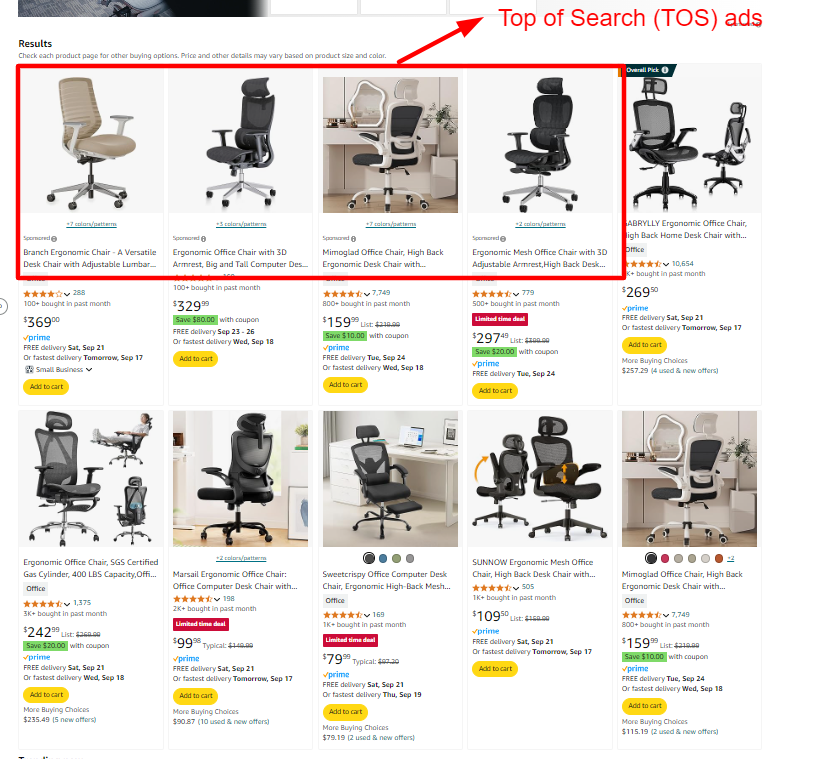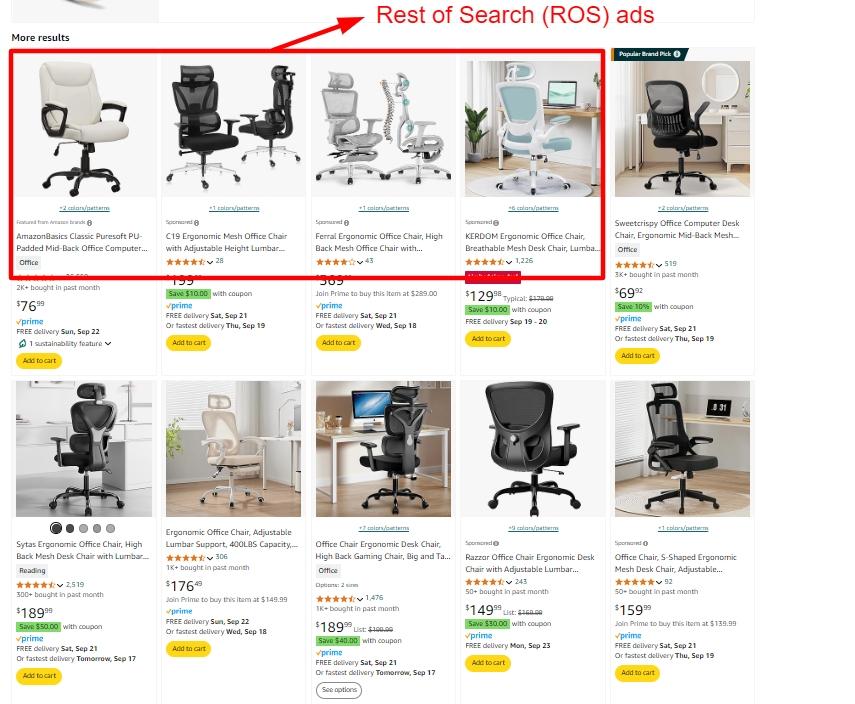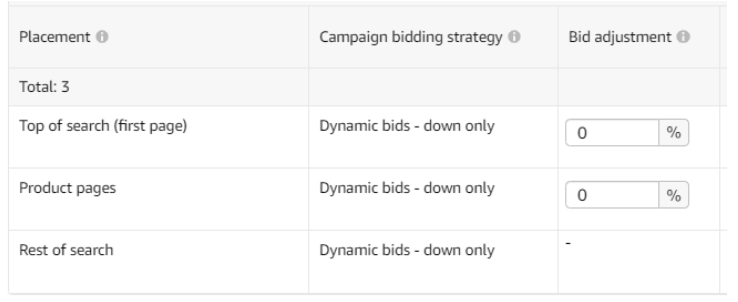When we talk about Amazon ad placements, most brands try their best to secure “Top of Search” placements, given their prominent visibility and higher conversion potential.
These ad placements often lead to better click-through rates (CTR) because they appear at the very top of the search results page, capturing the attention of potential buyers instantly.
However, as competition for these prime spots intensifies, the cost-per-click (CPC) is also rising, making it less cost-effective for every product or advertiser. This is where “Rest of Search” (ROS) enters as an underutilized yet valuable asset.
ROS placements may not enjoy the same immediate attention as Top of Search, but they offer distinct benefits that can help advertisers achieve a better return on ad spend (ROAS).
The lower competition in ROS means reduced CPCs, allowing brands to stretch their ad budgets further while still capturing customers who may be browsing later in the purchasing journey. By strategically optimizing for ROS placements, advertisers can unlock new opportunities to reach a broader audience at a lower cost, improving overall campaign efficiency and profitability.
In this post, we’ll take a closer look at why ROS is an essential part of your Amazon advertising strategy and provide actionable insights on how to maximize its potential.
Read More about Running Succesful Amazon PPC Campaigns
What is Rest of Search (ROS)?
Rest of Search (ROS) refers to ad placements on Amazon that appear after the top search results. When customers browse beyond the first few results, they encounter ROS ads, which can appear on later sections of search results on the first page or pages 2 and 3.
Although these ad placements don’t offer the same immediate visibility as “Top of Search” ads, they target shoppers who are more actively exploring different options. The benefit of ROS placements is lower competition, which results in reduced cost-per-click (CPC), making it a cost-effective option for advertisers who aim to maximize reach and ad performance.
Lower Competition – Lower Costs
One of the main advantages of focusing on Rest of Search (ROS) ad placements is the significant reduction in cost-per-click (CPC). Because, comparatively a few advertisers compete for these positions, the cost to secure a click is generally much lower than in more competitive placements like “Top of Search.”
This makes ROS especially appealing to advertisers who are working with limited budgets or looking to improve cost-efficiency. If you choose to go with ROS ads, you can drive traffic to your listings without incurring the steep costs often associated with higher-visibility positions, which is crucial for balancing overall ad spend.
Amazon’s Auction Model and ROS Advantage
In Amazon’s second-price auction model, advertisers who bid for premium spots such as Top of Search, face high CPCs as they compete with numerous other brands for top visibility. However, in ROS ad placements, where competition is comparatively low, advertisers can still reach potential customers while enjoying lower CPCs. This results in lower ad spending and potentially better cost-per-acquisition (CPA), which makes ROS an attractive option for those seeking to optimize their Amazon ad campaigns in highly saturated markets.
New Bid Adjustment Opportunities
We all know that Amazon’s advertising tools keep evolving. It has become easier for advertisers to adjust their bids, specifically for ROS placements, adding a new level of control and flexibility. By applying bid adjustments strategically, brands can utilize ROS ad placements as a cost-effective alternative to boost their visibility without significantly increasing their overall ad budget. This particularly benefits in competitive categories where the top spots are often dominated by larger companies that have good advertising budgets.
Cost-Effective ROAS
Another compelling reasons to target Rest of Search (ROS) placements is the potential to significantly improve your return on ad spend (ROAS) while keeping costs low. With reduced competition for these ad placements, advertisers benefit from lower cost-per-click (CPC), which allows for more efficient spending.
Despite the lower costs, ROS still attracts high-intent shoppers. Meaning? You can continue reaching a serious audience that is ready to make a purchase, all while keeping your ad spend under control and improving the overall effectiveness of your campaign.
To help brands make the most of ROS placements, our Amazon PPC management services can optimize your bids, lower CPC, and enhance overall ad efficiency. By leveraging advanced strategies tailored to your specific products, Signalytics ensures that you capture high-intent shoppers while maintaining a balanced ad budget.
Reaching High-Intent Shoppers with ROS Placements
Rest of Search (ROS) ad placements offer a unique opportunity to capture those potential shoppers who are often scrolling deeper into buying products. These customers are not merely browsing; they are comparing multiple options, reading reviews, and evaluating product details to make informed decisions. By the time they scroll past the top search results, they are likely serious about making a purchase.
ROS placements allow you to tap into this behavior, targeting high-intent customers who are still actively engaged in the shopping process but may need that final nudge to convert. This strategy can be particularly valuable in markets where customers are known to thoroughly research before committing to a purchase. When shoppers browse beyond the top results, they tend to be more deliberate, and their interest may actually increase as they assess various options.
By appearing in ROS placements, your product can reach this attentive audience who is ready to buy, helping you increase conversion rates while maintaining cost efficiency.
Greater Visibility Throughout the Customer Journey
Rest of Search (ROS) placements provide advertisers with the opportunity to maintain visibility across various stages of the customer journey. Shoppers may initially explore Top of Search ads but often continue scrolling to find more options, compare prices, or seek out products with better reviews.
By optimizing for ROS of your Amazon ads, you ensure that your brand remains visible as customers move deeper into the decision-making process, allowing you to capture their attention when they are actively considering their purchase options and potentially influencing their final decision.
Effective Strategies for Optimizing Rest of Search (ROS)
To fully leverage Rest of Search (ROS) placements and boost your Amazon advertising strategies and performance, it’s important to employ a well-pondered approach. ROS may offer lower cost-per-clicks, but without proper optimization, its potential could be underutilized. What do you need?
- Tailor your bidding
- Target the right keywords
- Continuous monitoring of ad performance
This way you can increase conversions while keeping your costs in check. Let’s explore some key strategies that can help you make the most of ROS placements and improve your overall return on ad spend (ROAS).
Use Placement Multipliers to Maximize Efficiency
One of the most effective strategies to optimize Rest of Search (ROS) placements is by utilizing placement multipliers. Amazon’s bidding system allows advertisers to adjust their bids specifically for ROS, giving you more control over your ad spend. Instead of applying a uniform bid across all placements, you can allocate higher bids for ROS to ensure your ads are competitive in these lower-cost areas. This strategy will help you to balance visibility and budget, ensuring that you don’t overspend on placements that don’t deliver the same ROI.
By strategically increasing your bid for ROS ad placements, you can maximize exposure while keeping costs manageable. Placement multipliers will allow you to fine-tune your bids based on how different placements are performing, ensuring your budget is being used efficiently. For instance, if you find that ROS is delivering strong conversions at a lower cost-per-click (CPC), you can gradually raise your bid multiplier for this placement to further boost visibility and capture more high-intent shoppers, all while maintaining a lower overall ad spend.
Target Broad Search Terms for Wider Reach
Rest of Search (ROS) ad placements perform exceptionally well when you focus on broad or generic search terms. Unlike specific keywords where shoppers know exactly what they’re looking for, broader terms like “women’s shoes” or “home décor” attract a wider range of shoppers still exploring options.
These searchers are more likely to scroll through multiple pages of results, providing your ads with greater visibility and more opportunities to engage high-intent customers. Broad search terms work well in ROS because they often have more search results and competition, causing shoppers to scroll further to compare options. This approach also tends to reduce cost-per-click (CPC) compared to targeting highly specific search terms, where customers tend to convert more quickly on the top results.
By focusing on generic keywords in ROS, you increase your chances of reaching shoppers who are still in the decision-making phase, allowing you to drive higher engagement and potentially boost conversions while keeping ad spend efficient.
Allocating TOS and ROS by Product
Not all products are equally suited for Top of Search (TOS) and Rest of Search (ROS) ad placements on Amazon. A targeted approach that allocates products (ASINs) between these placements can significantly boost your advertising efficiency. High-margin or top-performing ASINs, with strong conversion rates and positive reviews, should be prioritized for TOS placements to capitalize on visibility, even with higher costs.
Meanwhile, lower-margin, new, or less competitive ASINs can thrive in ROS placements, where reduced competition allows for cost-effective conversions without straining your ad budget. Additionally, a cross-targeting approach can combine both TOS and ROS placements for some ASINs.
This amazon advertising strategy allocates budget across both placements—using TOS for brand exposure and ROS for capturing later-stage shoppers—maximizing visibility throughout the customer journey while maintaining a balanced cost structure.
Conclusion: Maximizing the Potential of Rest of Search
Incorporating Rest of Search (ROS) ad placements into your Amazon advertising strategy can offer new opportunities for increased visibility, improved return on ad spend (ROAS), and cost-efficient conversions.
By employing targeted strategies like using placement multipliers, broadening your keyword focus, and allocating products between TOS and ROS based on performance, you can optimize your ad spend while capturing high-intent shoppers throughout their purchasing journey. ROS offers a valuable alternative to more expensive placements, allowing you to remain competitive without breaking the bank.




